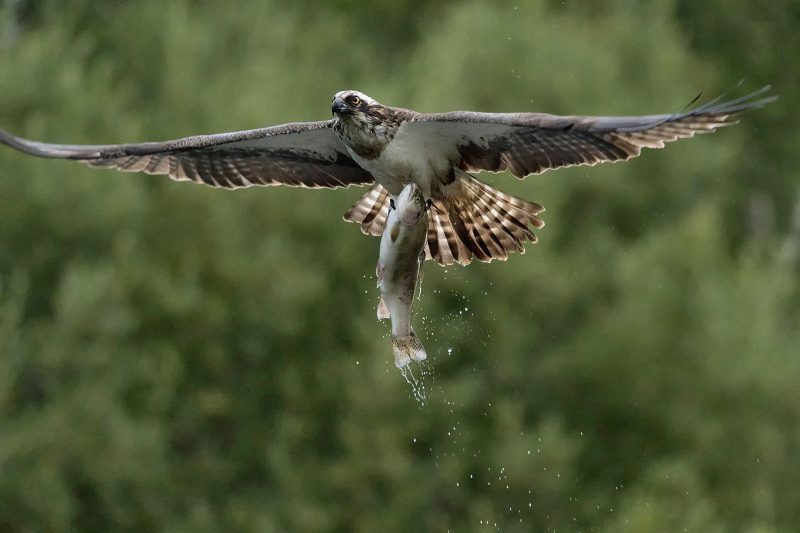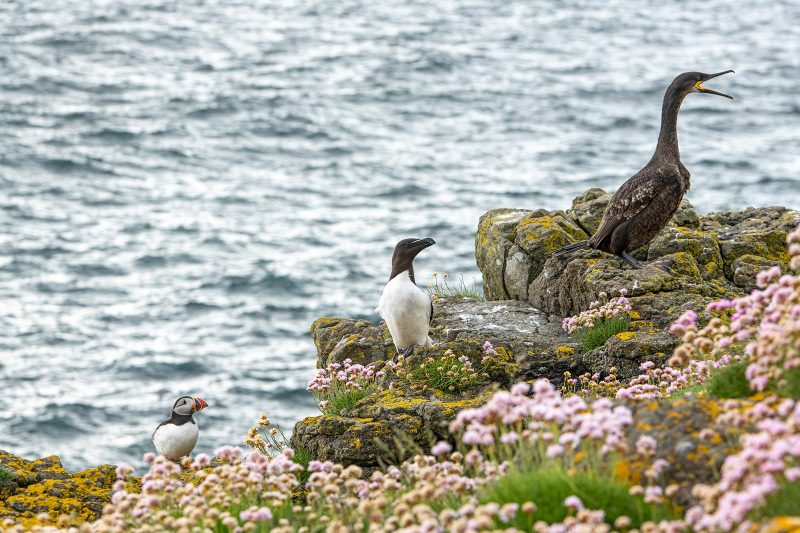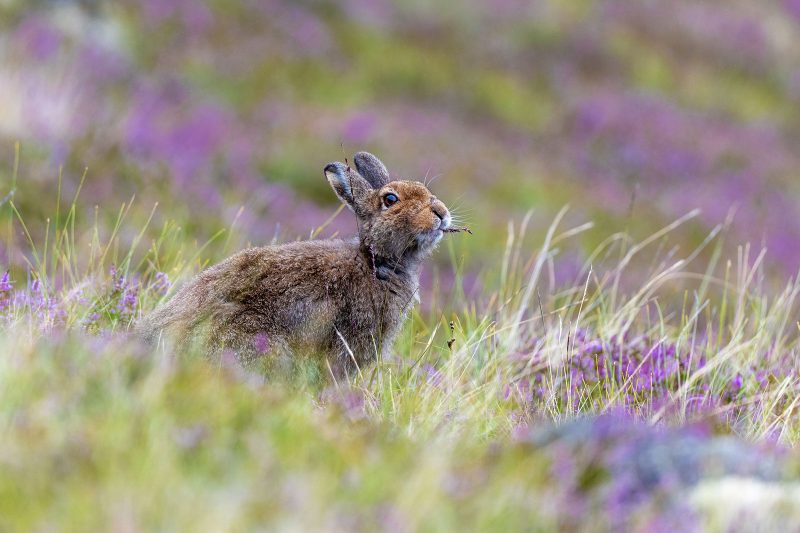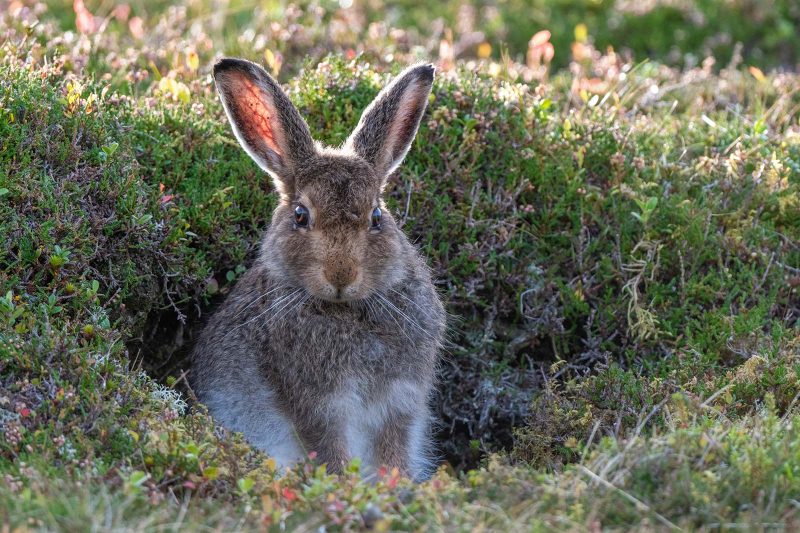Wildlife Photography Guide to Summer in the Scottish Highlands
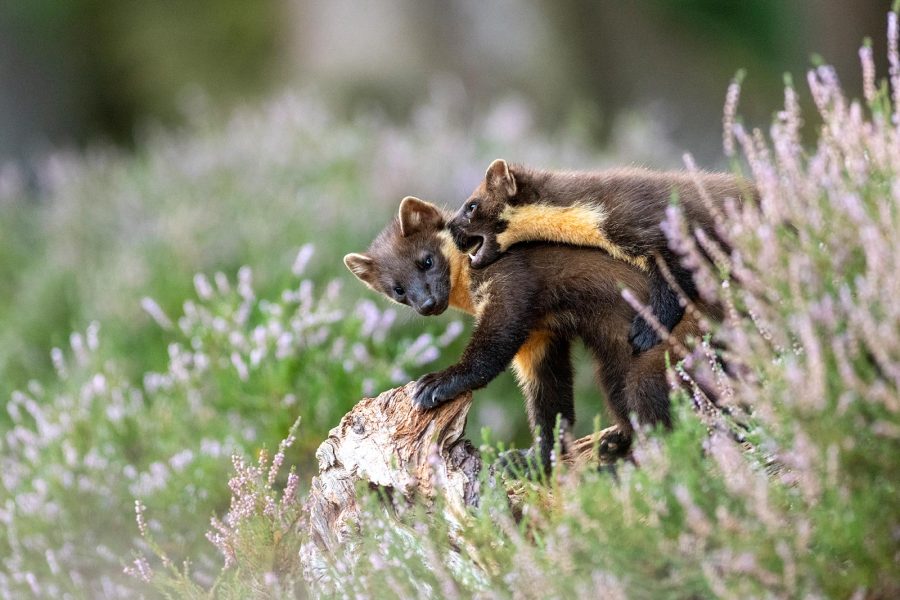
The Scottish Highlands are best known as a destination for winter photography– ptarmigan, red deer, mountain hares, crested tits, and snow bunting in snowy conditions. However, if you’re thinking of visiting in the summer months there’s still plenty to see.
Best time to visit the Scottish Highlands
If you’re visiting the Scottish Highlands for wildlife photography in the summer I recommend May or August, as you’ll avoid the peak holiday season. The Highlands became very busy during the pandemic, both with camper vans and people, making road travel frustratingly slow and many popular spots unbearable (Chanonry Point, for example).


By May most of the migrant birds have returned; badgers and pine martens can be visible in daylight hours, and both the dolphins and osprey are active. The gorse is in bloom too, which can allow for some gorgeous vibrant images. I especially like small, in-frame photographs of little birds in the gorse, like this image of a male stonechat.
August is my favourite summer month. If you can cope with the midges and aren’t hoping to photograph the seabirds (such as puffins) who will have departed, then you can enjoy the stunning purples and pinks of the flowering heather, carpeting hills and moorland.
I love to photograph wildlife in the heather and there are a number of things you can try. Wide-angle environment images will showcase the heather as much as the animal. For close ups, a shallow depth of field works well; this renders the heather a very soft pink colour in your photographs.
Regardless of which month you visit, there’s a plethora of wildlife to photograph throughout the summer. Take advantage of the long days to go out early and late in the day to avoid the harsh midday sun, and remember that cloudy days are best for both spotting and photographing the wildlife.
Read more: How to Photograph Wildlife in the Scottish Highlands
Photographing bottle-nosed dolphins
Watching the antics of bottle-nosed dolphins as they chase fish and leap high in the sky is an amazing experience. We’re very lucky up in the Highlands to have a large number of these mammals living in the Moray Firth and surrounding waters.
Although it’s possible to catch sight of them at any time during the year, you’re most likely to see the dolphins from late spring to early autumn as they fish for salmon, herring, and trout.
For close-up land-based encounters the best location is Chanonry Point on the Black Isle. Here, the geography of the land means there’s only a narrow channel for the dolphins and fish to swim through.
There are often one or two dolphins fishing exceptionally close to the shore, and at times the water can be filled with dolphins breaching and throwing fish up in the air- an incredible sight!
The dolphins tend to appear on a rising tide, so I’d advise arriving no more than an hour after low tide. You may still have a long wait, and they don’t always pass by or stop. But when they do, it’s worth it!
Photographing the dolphins isn’t easy as they can leap out of the water anywhere with little or no warning. Sometimes they are very close, and at other times much further away.
A telephoto zoom lens is the most versatile as you’ll be able to capture more of the action at a decent focal distance. It’s also worthwhile to keep the zoom quite wide, so that when looking through the viewfinder you’re more likely to spot the action.
There’s nothing more frustrating than finding yourself looking at empty sea, and then hearing whoops coming from other people on the beach, as the dolphins do something amazing outside your field of view!
I’d also recommend using a tripod or, ideally, a monopod, as holding your camera up for extended periods can be tiring.
Chanonry has its challenges though. Lots of families and photographers visit in the hope of seeing dolphins, so the beach can become very crowded. The tide comes in very quickly and, because of the number of people on the beach, if you’re standing amongst them you’ll be shuffling back regularly (the ‘Chanonry shuffle’). Wear wellies and you’ll be able to stay at the front!
The carpark is one of the worst I’ve ever been to. There’s a single track road through a golf course to get there and the car park itself has only a few very tight spaces.
As of 2022, camper-vans are banned from using the carpark. If you have one, you’ll need to stop elsewhere and walk to the point. You can park elsewhere and walk, or come early or late in the day. There are no toilet facilities, parking fees, and parking is limited to 3 hours.
The dolphins are often spotted anywhere along the East Coast from the Moray Firth upwards. You’re likely to see them if you go to Orkney, Shetland or the Hebrides too.
There are a number of companies offering dolphin/ wildlife trips out in the Moray Firth. These can be an excellent way to see and photograph the dolphins and other wildlife not usually seen at Chanonry, like harbour porpoise, orca, and seabirds. Dress warmly for these, as even on a sunny day it can be cold out at sea.
Read more: How to Photograph Dolphins
Photographing osprey
I always look forward to the return of the ospreys in April. These birds of prey eat only fish, so the best way to see them for free is to visit a body of water with a good fish supply. Take binoculars to help with spotting them.
Ospreys circle above looking for a fish in the water and then dive down, partly submerging, to try and hook it in their talons. They then somehow manage to pull themselves out of the water and fly off with the fish.
Whilst the female is sitting on eggs and having young, the male does all the food gathering. He will, however, often sit and eat the head of the fish before taking the rest of it back to the nest.
Ospreys are a Schedule 1 bird under the 1981 Countryside Act and it is a crime to disturb them at or near their nest site during the breeding period. So, it is best to watch as they fish at a distance from the nest or at a viewing hide.
One of the best times to watch ospreys fish is once the young have fledged; at this point you may well see both the parents and the youngsters over the water. The young will need some practice to successfully catch fish so will often make a few dives.
If you’d like the opportunity to photograph ospreys close up as they fish, there are places in Aviemore with early morning hides available to book. These are quite expensive, but you’ll have a good chance of getting some excellent views of the ospreys.
For this you’ll need a fast lens and a camera with a good buffer, plus a tripod, as the early light will be poor and the birds descend very quickly. A spotter will tell you when the birds are approaching so that you can be ready to capture the action.
It’s exhilarating and challenging, but to see these birds up close is amazing!
Read more: 4 Essential Tips for Photographing Birds in Flight
Photographing white-tailed sea eagles
These massive birds of prey are resident all year round, but over the summer you will have more opportunities to see and photograph them as they hunt for food to feed their hungry chicks.
These awesome birds have a large, yellow hooked bill and fearsome talons, and will eat anything. They’re most prevalent on the west coast and islands, although there are birds in the east now too, including the Cairngorm National Park.
For an opportunity to see them up close, there are a number of boat trips available on Mull, Skye, and the west coast, where the skipper will throw a fish in the water for the eagle to collect.
It’s best to have a medium length telephoto/ prime lens (300mm or thereabouts), which can ideally be hand held as you’ll be standing on the deck of the boat. Try tracking the eagle as it approaches, and be ready to start photographing as it starts the descent and scoops the fish out of the water with its talons.
Unlike the osprey, the eagle doesn’t submerge itself but skims the surface, rising back into the air with the fish.
Photographing puffins and other seabirds
In April seabirds start to return to the coastline and islands to breed, having spent the rest of the year out at sea. Empty cliffs are suddenly heavily populated and the sound of the birds in the busier colonies is quite incredible.
These birds can be seen at locations throughout the UK, but we have a few great spots for them in the Scottish Highlands, both on the mainland and the islands.
Puffins are most people’s favourite seabird. A member of the auk family, they mate for life but only see their partner during the breeding season. One of the most interesting times to photograph puffins is soon after they return to land. At this time they’ll re-establish bonds with their partner by billing: this is when they bang their beaks together.
There’s also the business of getting the nests ready for pufflings. Often you’ll be sitting watching, when suddenly dirt starts flying out of a burrow.
The puffins will waddle about searching for nesting material, pulling out grasses, and sometimes even spring flowers, to line their nests. This provides some great images. This is also a time when territorial fights take place between birds, which shows a completely different aggressive side to these clowns of the sea.
At this time in the season, I like to find a spot and sit with the same group of puffins for as long as possible. It’s good to sit or lie down so you’ll be at eye-level with the birds. By doing this you’ll be more likely to experience all these different behaviours.
Lens length really depends on the location. In some places, such as Lunga in the Treshnish Islands, the puffins are almost within touching distance. So, a short telephoto or prime (up to 300mm) is all that’s required (although you can bring longer lenses too).
In other locations, such as Handa, the puffins are a fair distance away so you’ll need a longer lens. Take a wide-angle lens with you as well because many of the seabird cliffs are beautiful.
Once the pufflings have hatched, the arduous and often dangerous job of feeding them begins. This is when you’re likely to see puffins with mouthfuls of sand eels. Watch out for predators, such as great/ arctic skua, black-headed gulls, and herring gulls, which may attempt to steal the fish from the puffins.
I once witnessed a gull pick up a puffin by its tail feathers, pull it out of the burrow it had flown into, and shake it until it dropped the sand eels. June and July are best for this.
Capturing puffins in flight can be a challenge. They move very quickly and often pop up from below. On these occasions, it’s almost impossible to get your camera onto them in time.
If it’s windy, you’ll have a much better chance as they fight the gusts to land. Very ungainly when landing, puffins will stick their feet out and almost crash into the land. I try and photograph them coming towards me.
The easiest way to photograph puffins in flight is to find focus when the bird is still a fair distance away, and track it until it is within a good distance for photographs. Then hit the shutter on continuous, and hope a few of the shots are in focus!
If you have a camera with good eye-tracking it will certainly help with this. As a Nikon DSLR user, I tend to put my D850 or D500 in group focus mode in the centre points, so that there’s a higher chance of the camera finding focus. I use spot focus for everything else.
Because puffins and many other seabirds are primarily black and white, you don’t want to photograph them on bright sunny days as you’ll either blow the highlights on their white chests or have very under-exposed images.
If possible, choose a cloudy day with hazy sunshine. If you’re photographing them at a location on the mainland, such as Dunnet Head in the far north, then you have the luxury of going early or late in the day. However, this isn’t possible on most of the day trips to islands.
If you do find yourself there on a sunny day, look for shadier parts of the location and try to expose for the white. It’s easier to retrieve detail in the shadows in post-production.
I ensure that one of the image review screens on my camera is set to show if the highlights are blown, and I adjust accordingly by dialling in some negative exposure compensation (the little +\- button on your camera). Alternatively, use a polarising or neutral-density (ND) filter to try and improve the exposure.
Many of the other seabirds that breed in Scotland have similar behaviours and are just as interesting to watch and photograph, even if they’re not as colourful as the puffins. Black guillemots are worth searching out with their dramatic red feet and mouths. You’ll often find them nesting in holes in harbour walls and they can be quite entertaining birds.
Read more: How to Harness Light in Bird Photography
Photographing pine martens
The summer months are the best time to see and photograph pine martens in daylight. They are something of a success story, having spread throughout the Scottish mainland, and can now be found in most wooded areas in the Scottish Highlands.
In locations where they feel safe or are habituated to humans (such as some guest accommodations), they will come looking for food at any time of the day, but most usually in the early morning and mid-late afternoon/ evening. This especially applies to nursing mothers who have hungry kits to feed.
The kits generally start appearing in early June. They are often very inquisitive and always very playful. However, they are shy animals that are very aware of changes to their environment and the presence of potential threats, so your chance of coming across one is still small.
To increase your chance of success, I recommend booking a session in a pine marten hide. This is likely to be the most photogenic option, or you could plan to stay in accommodation where they are known to visit.

They are big animals, so don’t use too long a focal length or you may not fit the whole animal in the frame. A fast lens is useful too as they will often appear at dusk.
Read more: 6 Tips for Better Fieldcraft in Wildlife Photography
Photographing common/ harbour seals
The vast majority of UK-based common seals are found in Scotland. They are actually less common than the grey seal. Common seals can be seen around the coastlines of both the mainland and the islands, including the Hebrides, Orkney, and Shetland. They give birth in June and July.
Over recent years they have suffered at the hands of photographers and tourists who approach far too closely. Therefore, if you are hoping to photograph them, please do stay back and adhere to any local restrictions. They are in place for a reason.
I’ve never been very close to seal pups but have observed and photographed from a fair distance away. Therefore, a long lens, and ideally a tripod, are required. Another way to see seal pups is to go on a boat trip; there are many of these offered around the coastline.
Read more: Ethics in Wildlife Photography – Code of Conduct
Photographing the Scottish wood ant
These might not be at the top of your must-see list, but they are fascinating to watch and a challenge to photograph!
Found in pockets of woodland in the Scottish Highlands, their nests have the appearance of large mounds of pine needles, but look closely and you’ll see hundreds of ants busy foraging for food. They are a large variety of ant (4.5-8mm), and are a beautiful amber colour.
Their nests are often in shaded areas and they move very fast, so an LED light or macro ring is helpful when photographing them, to allow you to push up the shutter speed.
Macro lenses (longer focal length ones) or close focusing telephotos work best. Choose a spot and wait for the ants to appear. Do not disturb the actual nest.
Read more: 5 Tips for Shooting Insect Macro Photos with Personality
What else might you see?
Two popular winter wildlife species– red squirrels and mountain hares– are both around in the summer months too.
Red squirrels may have lost their ear tufts but, unlike in winter when they are mostly just out in the mornings, they are active all day, and their tails turn a beautiful golden colour. You may also see some squirrel kittens which are adorable.
The kittens often have spindly tufts as well as long, skinny, orange tails. Unlike adult squirrels, which don’t tend to like one another very much, kitten siblings will play together and can often be seen entwined in the trees and on bird feeders.
Mountain hares are hard to find in the summer and much less approachable. The adults turn brown in April and disappear into the heather.
If you can find a leveret you’ll have a much better chance of getting some photographs. Leverets are born with fur and, although they spend some of their time down pre-existing holes in the peat or hiding amongst rocks, they do pop out and tend to stay in the same location, as it’s where the mother will come to nurse them overnight.
If you find a leveret, don’t approach too closely. Instead, sit quietly nearby. If the hare is flat to the ground (I call this a ‘pancake hare’), with ears pinned back and eyes wide, it is very stressed.
In this case I’d recommend leaving it be. Not only is the hare uncomfortable, but you won’t get any relaxed images or behaviours from it. However, sit patiently with a relaxed animal and you’ll be rewarded.
We do, of course, have many other species that can be photographed during the summer months, but many of these are found in other parts of the UK too. Some badgers venture out in daylight, there are dragonflies and damselflies, beautiful butterflies and moths, and a wide variety of migrant birds such as wheatear, warblers, and cuckoos.
So, plenty of photographic opportunities!
Read more: Composition in Wildlife Photography – Getting Creative
Midges and other biting beasties
The Highlands, especially the west coast, are renowned in the summer for midges. These tiny little insects, only 2-3mm in size, can make being outside a miserable experience and result in hundreds of itchy bites. Midges are most active at dawn and dusk and in cloudy conditions. They don’t like wind.
If, like me, you’re loved by these little monsters, you will need to defend yourselves against them. There are a number of repellents on the market including Smidge or Avon Skin So Soft.
It’s also worth investing in a midge net to go over your head. You will be very grateful for the protection it provides. Do make sure you purchase one that’s specifically for midges, not mosquitoes, as they are much smaller and can get through the holes in mosquito nets.
Fortunately, many of the preventative measures you will take against midges will work for mosquitos too. However, as they are significantly larger than midges, they can penetrate quite tough clothing.
Thirdly, you will need to consider ticks. They can be found anywhere there is tall grass, heather, etc. They are becoming increasingly common and, as 2021/2 winter was very mild, I’m predicting they will be really bad this summer. I’m writing this in April and have already had a few bites, and seen a lot on local wildlife!
The best way to avoid ticks is to tuck your trousers into your socks and always brush down your clothing before getting back in your car. If sitting/lying on the ground ensure your back isn’t bare, and I’d recommend not wearing shorts or short-sleeved tops.
It’s extremely important to remove ticks as they can give you Lyme disease which, if not treated as soon as possible, can be very nasty and last a lifetime.
Always check for ticks when you get home from a day on the hill. Initially they are really tiny, almost like a blackhead, but will grow as they feed and become really itchy when you shower. This is a useful way to discover if you have one in a hard to see area.
Even after you’ve removed a tick, check the bite site regularly for a few days. If it becomes inflamed or a circle forms around it, go to see a doctor immediately.
There is clothing available that has been treated to deter many of the above. You can also buy permethrin, which can be sprayed on outer clothing, and other products that you wash your clothes in to provide some protection. However, these don’t always work- I’ve been bitten through treated clothing more than once.
Finally, it does get hot and sunny here too! Even when windy or slightly overcast, if you’re outside all day remember to bring your sunscreen.
In conclusion
Come to the Scottish Highlands during the summer and, although you may have to look a little bit harder than during the winter, you’ll be rewarded with some wonderful wildlife experiences and photographic opportunities.
The days are long, so try to use the early morning and evening light where possible, and remember your insect repellents!




